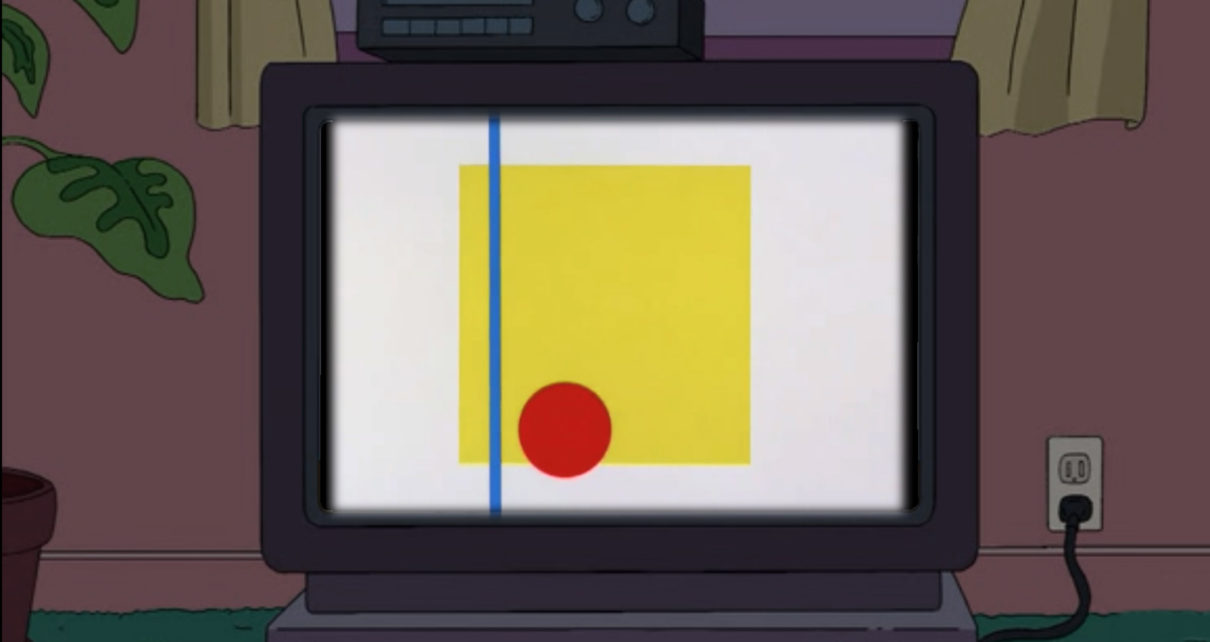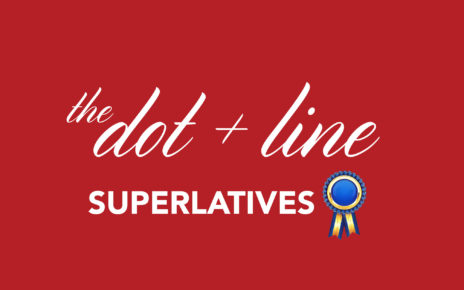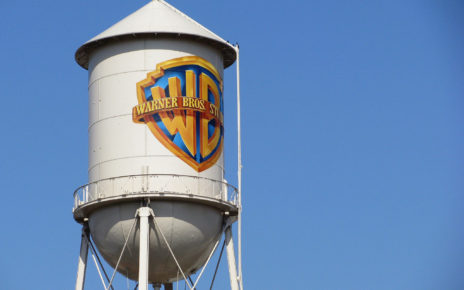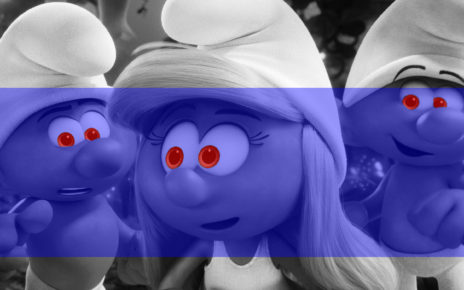The Dot and the Line, the cartoon from which this website borrowed its nom de guerre, turns 55 this year, on December 31. It was an adaptation of Norton Juster’s book The Dot and the Line: A Romance in Lower Mathematics and directed by master animator Chuck Jones. The 1965 cartoon short, released by Metro-Goldwyn-Mayer, is a beautiful piece of animation—full of bouncy curves and angular pivots and narrated by the great Robert Morley. It won Jones one of his three Academy Awards and also competed in the Short Film Palme d’Or at Cannes in 1966.

The cartoon—a love story between a line and a dot—was always going to outlast us here at the publication the Dot and Line, but as editors with a deep affinity for it, we knew we couldn’t close the site down without revisiting it one last time. Here’s the last Slack conversation we had as a staff about the short, gently edited for clarity.

Eric: So! The Dot and the Line. Is it still good!?
John: Here at the Dot and Line, we have a formula for determining whether something is still good: Product x Decay Over Time (DOT). To my mind, this film almost…defeats the purpose of this question, simply because, when conceiving of that formula for our column Is It Still Good!?, we did so in order to judge cartoons of, shall we say, a lesser pedigree. You would never catch us asking, for instance, if Looney Tunes is still good, because that’s a dumb question. (SWAT Kats: The Radical Squadron, however, was definitely fair game.)
Is The Dot and the Line still good? I mean, is H.P. Lovecraft’s horror writing still good? Is Ezra Pound’s poetry? This cartoon was, is, and always will be a work of artistic genius, full stop, and I think quite obviously so, in spite of its failures. Is the product still good? Hell yes, it’s still good. It’s beautiful, brilliant, strange, funny, thought-provoking, and extremely well made. It’s written by Norton Juster and directed by Chuck Jones! But did it decay over time? In certain ways, I think it did.
Elly: I mean, I am not a cartoon expert nor a cartoon critic so I might not know enough about the capital m Meaning of the cartoon when it originally came out. As far as I can tell, and I’ve watched it a good many times over the years since childhood, it’s supposed to be symbolic of changing yourself and contorting yourself to be what people want you to be, with the line shifting into different shapes to win the dot’s affection and the squiggle ultimately failing to untangle himself for the dot in the end. I kind of feel like, if anything, at least from my queer Jewish marginalized-ass perspective, that it’s done the opposite of decay over time. I think it gives us a really nice window into how relationships work and what kinds of different people exist in the world, and what it looks like to contort yourself for someone.
Eric: To my mind, The Dot and the Line is obviously still good and I was trolling even kicking off on the question. But I don’t even feel it’s good because it’s accrued more Meaning and or depth over time necessarily for me personally, but because its core concept is so rich with new rewards I notice every time I rewatch. I watched it again today and that was the first time I noticed the fact that in the sequence where the Line is talking about the Dot, the visuals literally place his idea of her on a pedestal, and the pedestal is engraved with the Latin “Ultimum Punctum.” It’s such a weird, trippy masterpiece of filmmaking full of so many surprises, and while the love story to me remains a lil heteronormative and simple by today’s standards, Jones is good enough a director and Robert Morley is good enough a narrator and Norton Juster’s idea was bulletproof enough to make it still last. Several times over I really wished I was watching a restored HD version (which I’m not totally sure exists?), because it’s just so detailed!
Sammy: I’ll admit that I hadn’t heard of this film until I met John and EVB, so I can’t compare with childhood impressions, but I agree with Eric on its fantastic details and little new fun things to find with every watch. It’s so unbelievably well done, although plot-wise, I was like, c’mon, Line, find someone who loves you not just for your cool shapes ’n stuff, but for your cool HEART ’n stuff. Line, you deserve better. But yes, I do think it’s Still Good, for sure.
Marley: I strongly agree with Sammy. As is often the case in “Two Princes” situations, I felt that both potential suitors were lacking. Even the ending seems bittersweet, and leaves me hoping for a remake where we see the dot inspired by another animated work (Brave) and chooses herself, in all her 36x36x36 glory (which like, same.) There’s no denying the appeal of the storytelling, however, and of course the ~ a e s t h e t i c ~ more than stands the test of time. It’s well worth viewing in this day and age, and as the resident library cryptid, I have to encourage everyone to read the book as well! Am I oversimplifying? Actually, am I disagreeing with Sammy? Whatevs. Dot is a strong independent point in space and doesn’t need either vectors or randomly assembled sets!
Sammy: No, you’re not disagreeing with me! You’re raising a separate point, which is that Dot should not be defined in this film by her suitors. And I agree. So. Huzzah!
Elly: That’s a great point! Right on the money. On the dot.
Sammy: Ayyyyyyyyy.
John: Marley, I wouldn’t say you’re oversimplifying! I’d say you’re just choosing the things you wish to focus on. Eric and I have actually hashed this out before, believe it or not (I know you believe it) and that time, I think we were pretty attentive to what I still consider the short’s major flaws: its patriarchal context and its male gaze. That said, it was the 1960s! So that, I think, is what I was trying to get at re: decay over time. The central story is still powerful, even though there are a couple of cringe-worthy moments or takeaways.
Elly: Wait, you want my take on the patriarchy of it all?
Sammy: Lady here: I definitely think central plotline is dated. I mean, if you think about it, it’s literally ancient: It’s a mating ritual! The dude lines are putting on a performance for the girl dot! So she can decide which one to fuck!!! Definitely problematic. But it was over half a century ago, and we’ve come a long way. I think we can still appreciate the finer points of the film as long as we acknowledge its problems. Plus, of course, it’s super heteronormative, and the takeaway is literally “change yourself and you’ll get the gal/fella!”
Elly: Agree. My least favorite part of it. Would be better if we queered it.
Sammy: Although of course it could more optimistically be seen as “growth” rather than “changing.”
Elly: Yeah, I fail to see it that optimistically, unfortunately. Just very patriarchal. But I enjoy at least it’s not the dot changing for the line.
Sammy: Yes, very true.
Marley: On one hand, I know there’s a lot of appeal to a story of (initially) unrequited love that does eventually result in a relationship, even if it takes one hell of a bender to get there. But from a more symbolic side of things, it gets tricky: should you change yourself for love? Is it change, or growth? Is Line actually a series of Dots, so this isn’t really a change, per se, but simply revealing his more compatible traits? Am I applying too much actual math to this? The answer to the last one is yes.
Eric: I obviously still think it doesn’t have great politics and remains very heteronormative. But also, rewatching it, I liked that the Very British Morley narration and the end are also sorta cheeky about the love story, and the film leaves some room for interpretation as to whether it’s a good thing they’re together at the end. The last line is: “And soon they lived, if not happily ever after, at least reasonably so!” Although all the points above are obviously true and valid, of course.
It all leads me to believe there might be more to The Dot and the Line‘s love story than either the pure mathematics (which are very present in the short, Marley, so I don’t think bringing them in is wrong AT ALL) or what we wind up seeing on screen. We get no guarantees that the Line won’t wind up a cheater and that the Dot won’t dump his ass the minute she sees a hint of crookedness in his path.
That said we don’t get any of that, and I think it’s also worth remembering/noting that this won Jones one of his three Oscars, which is a big reason we still celebrate it. If there’s anything Hollywood’s taught us, it’s that sentimentality wins awards, whether it’s intentioned or not.
Sammy: Oooh yes, very good points.
John: I’d actually like to pivot, if I may, from love to absence, which you all know is characteristic of me. And in doing so, I want to draw your attention to an incredible Instagram account called @looneytunesbackgrounds, which collects backgrounds from Looney Tunes cartoons. Have y’all seen this?
Marley: Tag yourself. I’m Cheese Vault (from The Mouse That Jack Built).
Elly: I’m the bath (from The Aristo-Cat).
Eric: I am the arches, obviously (from Beep, Beep).
Sammy: Instagram keeps trying to make me log in, and mine’s deactivated. Though I am fond of the cheese vault.
John: I’m the lonely cab in the desert (from All A-Bir-r-r-d). Anyway, if you take a look through this Instagram, you’ll notice that 1. all of these backgrounds are incredible and 2. roughly half of them are from cartoons by one Charles M. Jones. That says a lot about Jones’s visual eye and also a lot about Maurice Noble, his right-hand man and a prolific background designer. It also says something kind of amazing about this short which, like one of Jones’s other best and most acclaimed works, Duck Amuck, does not rely on background work much at all. It’s all in the storytelling and the character animation.
Eric: So one thing I think is worth pointing out, which Chuck Jones’s last protégé, Stephen Fossati, once told me, is that Jones was a master draftsman. He would literally produce dozens and dozens of versions of the same drawing because he was such a perfectionist about his character animation and what he wanted Bugs or Daffy or any of his many other characters to look like. So it’s funny that The Dot and the Line—which stars two of the simplest shapes he possibly could have drawn—is so iconic and has this legacy for us but also isn’t diminished in any way by its lack of backgrounds. For Jones it was probably a real test of his skill. Compare it to something like What’s Opera, Doc?, which has some of the most dramatic backgrounds ever, lotsa “wide” shots that stage Bugs and Elmer as tiny. Something like The Dot and the Line probably meant more work for Jones and his animators, but it obviously paid off.
John: There’s a metaphor there, Eric, for you and me. We are each a very different kind of perfectionist, but we’re both perfectionists to some degree, and I think what Chuck wanted out of Bugs or Daffy is what we often wanted out of an insane 30+-piece package or a 200-word blog, and certainly what we wanted out of The Site As a Whole. And while I’ll always know there was no way we could ever measure up to the name we chose for ourselves, I always hoped we’d at least do Chuck proud, somehow. I hope we did.
Eric: I have nothing to add to that except: Same.
John: That actually brings us almost full circle, I think—or at least, uh, dots the line—so let me ask one last question. When Eric and I first dreamed up this site, we were modeling it in part on the late, great Grantland, which was named after the legendary sports journalist Grantland Rice. Initially, we were going to call it Jonesland. (Jonesville would have been better.) Obviously, we made the superior choice. But did we make the right choice in naming our site after this short? And have we done that short justice?
Elly: OOOOHHHH. Well, what was your reasoning for choosing the name? What was “the Dot and Line” supposed to represent?
Eric: One sec, I’ve been washing dishes while watching this chat. Drying off…
Elly: Congratulations on turning into a housewife during this pandemic, Eric. We love this for you. (Gotta punch up, sorry.)
John: Eric will never be half the housewife I am. I’m the line and the dot. he’s the squiggle.
Elly: I’m the black hole.
Eric, OK, OK: Many factors went into calling this site what we wound up calling it. We wanted something iconic and memorable. We wanted its name to be multi-syllabic and somewhat musical. I don’t think we really vocalized it, but I think John and I were both keenly aware of the fact that we were men obsessing over a historically male-dominated art form. I don’t think either of us wanted our name to sound overly masculine or too tightly clipped—something like The Toon, for example, would have been wrong. And we were also not publishing news, but analysis and essays, so, like, Toon Beat or something like it also would have been wrong.
We did want to reference the dearly departed Grantland, which died a few months before we eventually launched, and which we always loved. We were also inspired, at least in tone and attitude, by the friendliness and community of the early and middle days of the AV Club, as well as the focus of its film-focused offspring The Dissolve. With all those influences in mind, we eventually went the Grantland route and referenced our favorite American animator from the first Golden Age of American Animation. Like John said, our early ideas were all bad, but somewhere along the line—
John: Heh.
Eric: —we rediscovered the sorta semi-obscure The Dot and the Line short after going down a YouTube wormhole, and we tweaked it slightly, resulting in: The Dot and Line. It felt right. At that time, it wasn’t too overused as a brand by other entities—there’s now more than a few others with some version of it, including a women’s clothing brand that sorta validates my notion on the masculinity thing—and I think we thought it was fun to say and reflective of the duality of our partnership back then, as well as expansive. All animation—and most art, for that matter—basically comes from dots and lines. It was also a fun little reference to The Wire, which John hadn’t seen yet when we started, but was always a side benefit for me.
One important thing here is that the romance of The Dot and the Line is also reflective of a romanticized view of blogging and digital journalism that we had when we launched this site. Grantland had just died. The editors of the Awl at the time, one of our other favorite websites—we actually referred to our shortest pieces as “Balkforms” after the great Alex Balk for a long time, although he wasn’t the editor of the Awl at that time—were on their way out. We were already deep in the 2016 presidential campaign, though Trump had not yet been elected. The Dot and Line was born out of the same idealized vision of possibility that you see in the creativity of Jones’s short—which is another reason I defend the short despite its corniness today. To me, the name was defiant of all these outside factors.
Elly: Then we have by all means done it justice. The Dot and Line has always been about being expansive and highlighting as many voices as possible for as long as I’ve been a part of it the last three years and I’m sure before that as well. It totally embodies that feeling and idea of limitlessness. And I think the name shows nuance and options and potential. It’s different! And super memorable.
Sammy: It also just rolls off the tongue. Got that X FACTAH.
Marley: This is gonna be a long-ass anecdotal answer.
Eric: Do it! In the meantime, some fast facts from the Wikipedia page’s “Notes” section about The Dot and the Line:
- This was one of only two non-Tom and Jerry animated short subjects to be released by Metro-Goldwyn-Mayer post-1958. The other one is The Bear That Wasn’t, released in 1967 as the last-ever MGM animated short.
- “The Dot and the Line” won the final award for an animated short for Metro-Goldwyn-Mayer, and Chuck Jones’ only award as a producer.
- This would be one of two Juster books to be adapted for the big screen by Chuck Jones, although Juster had no involvement with the other, The Phantom Tollbooth.
- Unlike other MGM Cartoons from 1963–67, the lion in this film is Leo.
Sammy: The lion is a Leo!?
Eric: Rightttt????!!!!
John: Holy hell, WAS THE PHANTOM TOLLBOOTH MOVIE GOOD!? Wait, MEL BLANC WAS IN IT! But Norton Juster hated it lol.
Eric: IT HAS 100% ON ROTTEN TOMATOES.
John: Norton Juster must be rolling in his grave: “It was a film I never liked. I don’t think they did a good job on it. It’s been around for a long time. It was well reviewed, which also made me angry.” Take that, Alan Moore.
Eric: It’s the 50th anniversary in November.
John: Alas, there will be no Dot and Line to praise it.
Eric: RIP.
Sammy: I just housed a whole sleeve of Peeps while this was happening.
Eric: That’s the dek on the post right there.
John: We’re sorry, Marley.
Marley: OK, dangerous amounts of cheese incoming.
I was depressed and stuck in life when I found The Dot and Line on Medium, and immediately pitched a semi-sad story about Bob’s Burgers. One fateful response later revealed a path towards a place to cry about connect with fans around my favorite cartoons, interview the creators that bring these incredible works of art to life, and make lifelong friends in the process. The Dot and Line has opened doors to opportunities I never thought possible, and has helped me transform my life into one that I love. Maybe the transformative power of love is the real message of this short, in the end. And if so, I know that our collective love of cartoons has helped us create something as unique and magical as animation itself.
John: Wow I’m crying.
Sammy: Aw, hell, that’s lovely, and the perfect amount of cheese. We love you, Marley!
Eric: I’M EATING ALL THE CHEESE.
John: Stuff me with cheese. Like this:

Eric: EXTRA SHARP CHEDDAR!
Sammy: I would like cartoon Swiss. Even though I hate Swiss IRL.
Marley: I love all y’all, and this amazing project that we’ve built together!!!
John: I need Hayao Miyazaki to personally draw me a cheese, so that Marley can stuff me full of it.
Eric: Anything else to add?
Sammy: Honestly, no. I think y’all hit the nail on the head. The Dot and Line is The Best Name.
John: One for the vault, one might say. Just not the cheese vault.

Thanks for reading The Dot and Line, where we’ve written about animation of all kinds for more than four years. We’ll miss you! If you’ll miss us too, show us some love on Twitter and show our writers the money on GoFundMe. Read our goodbyes here: That’s All, Folks!





